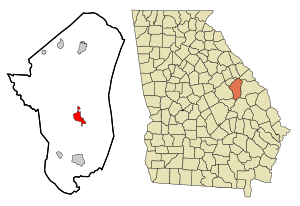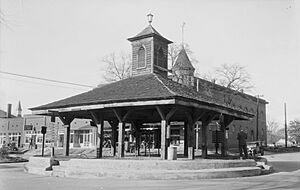Louisville, Georgia facts for kids
Quick facts for kids
Louisville, Georgia
|
|
|---|---|

Jefferson County Courthouse
|
|
| Motto(s):
"A Capital Community"
|
|

Location in Jefferson County and the state of Georgia
|
|
| Country | |
| State | |
| County | Jefferson |
| Incorporated | January 26, 1786 |
| Named for | Louis XVI |
| Government | |
| • Type | Mayor-Council |
| Area | |
| • Total | 3.68 sq mi (9.53 km2) |
| • Land | 3.61 sq mi (9.35 km2) |
| • Water | 0.07 sq mi (0.17 km2) |
| Elevation | 322 ft (98 m) |
| Population
(2020)
|
|
| • Total | 2,381 |
| • Density | 659.37/sq mi (254.57/km2) |
| Time zone | UTC-5 (Eastern (EST)) |
| • Summer (DST) | UTC-4 (EDT) |
| ZIP code(s) |
30434
|
| Area code(s) | 478 |
| FIPS code | 13-47560 |
| GNIS feature ID | 0332271 |
| Major airport | AGS |
Louisville is a city in Jefferson County, Georgia, United States. It is the county seat, meaning it's where the county government is located. Louisville was once the capital city of Georgia.
The city is southwest of Augusta, right by the Ogeechee River. In 2020, about 2,381 people lived there. The name "Louisville" is pronounced "Lewis-ville." Both this city and the one in Kentucky were named after Louis XVI, who was the King of France.
Contents
History of Louisville

Louisville became an official city on January 26, 1786. It was planned to be the state capital, but it took ten years for that to happen. Before Louisville, Savannah was the capital. But as Georgia grew, Savannah was too far from most people. So, Augusta became the capital in the 1780s.
Naming the City
Louisville was named after Louis XVI. He was the King of France and helped the American colonies during the American Revolutionary War. The city was named for him while he was still king. It took several years to build the city. The state government buildings were finished in 1795. There's an old cemetery for Revolutionary War soldiers on the west side of town.
Georgia's Capital City
Louisville was the capital of Georgia from 1796 to 1806. It was a busy place for trade, lawmakers, and political decisions. The Jefferson County courthouse, built in 1904, stands where Georgia's first permanent capitol building used to be.
The Old Market
Louisville has a historic open-sided market house called the Old Market. It's still in the center of downtown. This market was a central spot where people sold farm goods and household items. It was also a place where enslaved African Americans were sold. A photograph from 1934 at the Library of Congress confirms this. The Old Market is now listed on the National Register of Historic Places.
When Louisville was the state capital, many roads and transportation routes met at the market square. It was the main hub for the whole region. Later, the state capital moved to Milledgeville and then to Atlanta.
Today, Louisville is a smaller city and the county seat. It has a few main businesses. Queensborough National Bank and Trust Company was started in Louisville in 1902. It is still based there on U.S. Highway 1.
Geography of Louisville
Louisville is located a little south of the middle of Jefferson County. U.S. Route 1 goes through the east side of the city. It leads northeast about 46 miles (74 km) to Augusta. It also goes south about 30 miles (48 km) to Swainsboro.
U.S. Route 221 runs through the north side of downtown as Peachtree Street. It goes southwest about 10 miles (16 km) to Bartow. US-221 also leaves Louisville to the north, joining with US-1 for about 15 miles (24 km) to Wrens.
Louisville has a total area of about 3.68 square miles (9.5 square kilometers). Most of this is land, and a small part is water. The western edge of the city follows Rocky Comfort Creek. This creek flows into the Ogeechee River at the city's southwest corner. The Ogeechee River then flows to the Atlantic Ocean, south of Savannah.
Population of Louisville
| Historical population | |||
|---|---|---|---|
| Census | Pop. | %± | |
| 1810 | 524 | — | |
| 1820 | 694 | 32.4% | |
| 1870 | 356 | — | |
| 1880 | 575 | 61.5% | |
| 1890 | 836 | 45.4% | |
| 1900 | 1,009 | 20.7% | |
| 1910 | 1,039 | 3.0% | |
| 1920 | 1,040 | 0.1% | |
| 1930 | 1,650 | 58.7% | |
| 1940 | 1,803 | 9.3% | |
| 1950 | 2,231 | 23.7% | |
| 1960 | 2,413 | 8.2% | |
| 1970 | 2,691 | 11.5% | |
| 1980 | 2,823 | 4.9% | |
| 1990 | 2,429 | −14.0% | |
| 2000 | 2,712 | 11.7% | |
| 2010 | 2,493 | −8.1% | |
| 2020 | 2,381 | −4.5% | |
| U.S. Decennial Census 1850-1870 1870-1880 1890-1910 1920-1930 1940 1950 1960 1970 1980 1990 2000 2010 |
|||
| Race | Num. | Perc. |
|---|---|---|
| White (non-Hispanic) | 633 | 26.59% |
| Black or African American (non-Hispanic) | 1,615 | 67.83% |
| Native American | 1 | 0.04% |
| Asian | 25 | 1.05% |
| Other/Mixed | 53 | 2.23% |
| Hispanic or Latino | 54 | 2.27% |
In 2020, the United States census counted 2,381 people living in Louisville. There were 897 households and 606 families in the city.
Education in Louisville
Jefferson County School District
The Jefferson County School District serves students from pre-school through twelfth grade. It has two elementary schools, two middle schools, one high school, and an academy school. The district has 199 full-time teachers and teaches over 3,526 students.
- Louisville Academy
- Carver Elementary School
- Wrens Elementary School
- Jefferson County Middle School
- Jefferson County High School
Private Schools
- Thomas Jefferson Academy
Famous People from Louisville
Many notable people have connections to Louisville, Georgia. Here are a few:
- William Wright Abbot III (1922-2009), a historian
- John M. Berrien (1781-1856), a US Senator and US Attorney General
- Howell Cobb (1815-1868), a former Governor of Georgia and Speaker of the House
- Clarence Ditlow (1944-2016), a consumer advocate for car safety
- Herschel V. Johnson (1812-1880), a former Governor of Georgia
- Spike Jones (1947-), an NFL punter
- Mirabeau B. Lamar (1798-1859), the second President of the Republic of Texas
- John Milton (1807-1865), a former Governor of Florida
See also
 In Spanish: Louisville (Georgia) para niños
In Spanish: Louisville (Georgia) para niños


